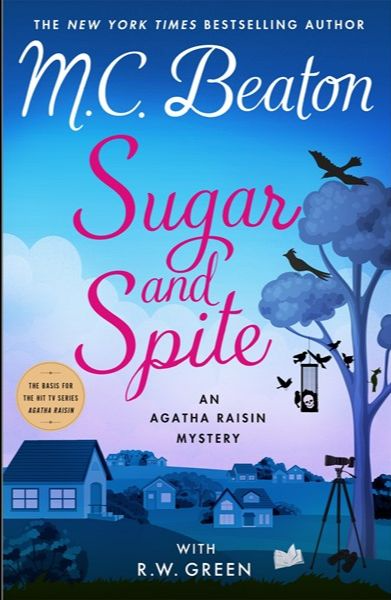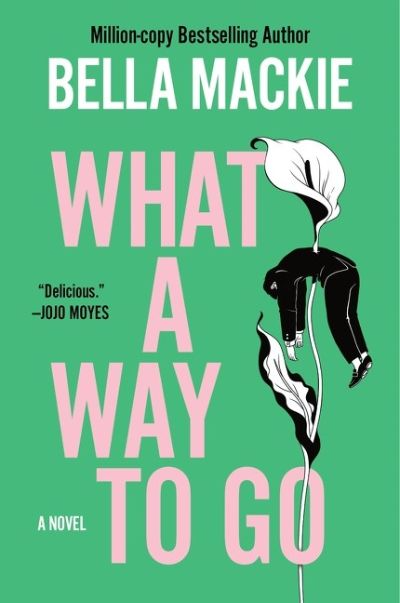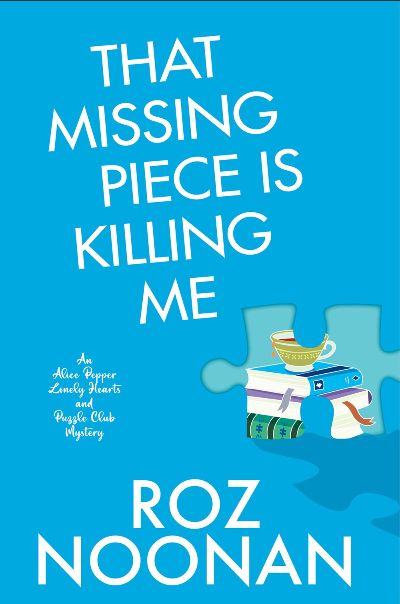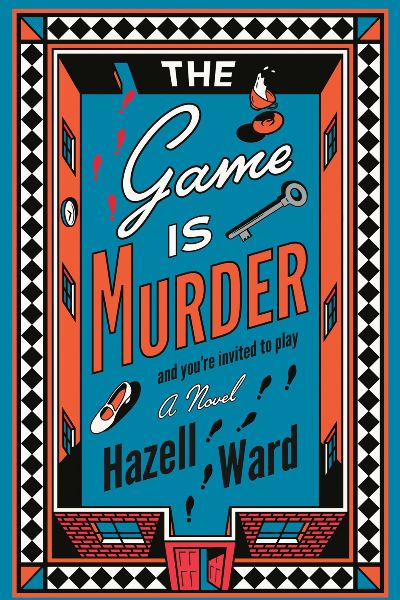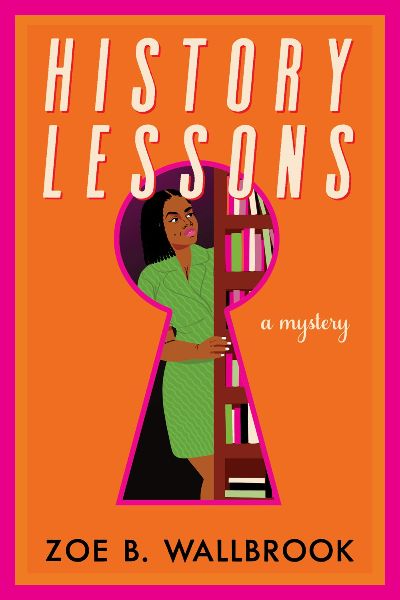Fortunately for M.C. Beaton (aka Marian Chesney) fans, this sixth Agatha Raisin novel created since Beaton’s demise, and written by R. W. Greenby, provides all the fun they are looking for. Mrs. Bloxby, the Vicar’s wife, convinces Agatha to attend a lecture by the Carsely Ladies Society to be delivered by three bird watchers (they call themselves twitchers). Agatha expects a dull evening but it turns out to be quite the opposite as a local farmer breaks up the lecture and threatens the women for trespassing on his land, and then the trio of twitchers ends up having a full-on war among one another. The next day, Agatha learns that one of the women has been discovered dead, and the rather dumb police chief insists it isn’t murder. So off we go, as Agatha takes up the search for the murderer, using the staff of her detective agency, friends, and inside knowledge from the police themselves. A pleasure, but brace yourself for a very surprising ending.
Amateur Sleuth
Margaret, large, 50ish, probably neurodivergent, is a remarkably good assistant in a university lab doing botanical research into possible cancer cures. The bottom drops out of her world when she discovers the body of her beloved boss, Dr. Deaver, in his office, quite dead. In true scientific fashion, she notices the small details that no one else, especially the bumbling campus police, takes account of. Her comments are quickly dismissed and she is pressed into rewriting an important grant application to credit someone who deserves no credit at all. There are deans grasping for academic glory, scientists looking to make big bucks, and only Margaret who wants to know the truth. She finds a friend in Joe, a new custodian whose personality seems out of keeping with his job. Together they work to discover what is truly going on, and not only find a murderer, but also save the cutting-edge research study. Margaret is a delight, and the situation requires her to open herself to friends and new possibilities. The ending leaves the possibility for more from Margaret and Joe, which would be a fine addition to the genre.
Tiny Dickens Island, located in the sound between Connecticut and Long Island, has a small permanent population composed of families in the midst of some sort of feud or another. Delia has come back after years of living in Manhattan to take up her role as mother to teenage Connor and part manager of the family’s general store. She’s inherited her grandmother’s house and for now is loving being back, though is unsure of her maternal success. Connor finds a secret room in grandma’s house with old books and what may be a pirate map. Delia encounters grandma’s ghost, who visits the room occasionally and offers a unique perspective on island history. The map is stolen by local miscreants and doesn’t lead to treasure but rather to a long-buried body that brings old scandals to the present. With logic, the help of an old love, and grandma’s ghost, Delia puts much of the puzzle together, leading to a solution to the murders and to some of the family feuds. An enjoyable, sandy cozy with the author’s promise of more to come from Dickens Island.
Yes indeed, this is certainly one hell of a way to go. When Anthony Wistern has a bit of an accident during his 60th birthday—he falls onto an expensive, large party decoration that pierces him—he ends up dead, of all things. Worse, he finds himself to be in a sort of rundown waiting room, where he is meant to stay until he can recall what or who it was that killed him. He’s reputed to be vastly wealthy—though does he actually have the funds to back up his claims of belonging to the one percent?—and all his family cares about, from his sarcastic wife Oliva to their four useless, repugnant, and adult children, is what Anthony had in the bank. Obsessively watching his family on Limbo TV, hoping for some hints as to how he died, which would allow him to get sprung, Anthony is astonished to find that no one seems to be making any sort of fuss over his demise. In fact, Olivia seems quite put out at the mess he has left behind, including both his financial problems (where did the money go?) and social issues (such as a mistress). The book is narrated by Anthony; Olivia; and a third character, the Sleuth, a young woman, an obsessive blogger, and a true-crime fanatic who is convinced Anthony was murdered and will jump over any fence to prove it. As with Mackie’s earlier book, How to Kill Your Family, this is chock full of plots both large and small, although when it comes to dark humor, this book is the clear winner.
Alice Pepper has one busy life. She’s director of the West Hazel, Oregon, public library. She’s the center of a group of friends—all puzzle fanatics—who regularly meet for meals and puzzling. And she’s got plenty of family members, like her nieces, whose lives she needs to keep an eye on. She may have had to put off retirement because her divorce has wiped out much of her savings, but Alice always keeps focused on what’s important. And in much of this book it’s the disappearance of her friend Michelle Chong, martial and visual artist, that has Alice’s attention. Did Michelle run away, finally escaping from that no-good husband to create a life elsewhere, or was she a victim of domestic violence? Nearly half the book is devoted to searching for Michelle, and once that’s resolved this second book in the series (after Puzzle Me a Murder) expands deeper into Alice’s world—which is loving and caring, yes, but also features major pieces of the past she has been unable to resolve. For fans of Richard Osman, Nancy Bush, and Leslie Meier.
In Ward’s clever and unusual debut, the reader is put to work solving a murder, their task propelled by a sassy narrator who insults them throughout. The tale opens with murder-mystery dinner at which guests hear the story of a nanny who’s murdered in a case of mistaken identity; when the former man of the house, Lord Verreman, discovers that he hasn’t killed his wife, Lady Verreman is able to escape. At least, that’s what police believe. At the dinner, guests are told of various anomalies at the scene and alibis and motives for others connected to the case, and are led through the inquest after the nanny’s autopsy. Then the viewpoint switches: a detective is hired by the rich couple’s son and is required to visit the the home where the murder happened, hear the evidence—in a most unusual delivery—and reveal the culprit. These first two sections are unusual enough, but the third tops them: the reader is presented with all the evidence and must make choices step by step as to what they believe, in the end reaching a verdict of their own (a contract is in place, after all). What an intriguing start for this author!
I possess real expertise in only a few areas. Just two, in fact. One is crime fiction, and the other is public libraries and what makes them work. So naturally I was pretty elated to come across The Librarians, and I’m happy to report that Sherry Thomas portrays libraries and librarians as accurately as I have ever come across in a book. Set in a modest branch library in the suburbs of Austin, Texas, the novel dwells on four quirky staff members, each of whom has found both a sense of purpose and a home in the library, as well as strong friendships. But after the library’s new game night, two library users are found dead. And remarkably, these deaths trigger stories from each of the librarians, with each one finding their lives turned upside down. Thomas is a much-lauded author of historical romance, and this book shares in the eloquent writing she is known for. Perfect for a book-group discussion.
Have you ever noticed that vampires (not to mention werewolves, elves, and others) always get the short end of the stick? Take Arthur and his husband, Salvatore (Sal), for example. Two vampires in love, they have recently opened a bed & breakfast in rural Oregon. Life is sweet, but while vampires are sometimes accepted, there are plenty of not-so-paranormal-friendly attitudes to go around, and much of their time is devoted to educating their new neighbors (garlic is O.K., they don’t bite—really!—and they go out in the sun, but use plenty of sunblock not because of a reaction, but to stay young looking). So when the mayor is found dead in their garden, with two puncture rooms in his neck, Arthur and Sal end up accused of the mayor’s murder, to the point where Sal is jailed. How will the two of them—along with a few friends—manage to find the real murderer, exonerating themselves? A pleasure to read from beginning to end, with plenty of humor, Dead & Breakfast should find an audience from young adults through retirees.
My fear of woodland creatures (read “bears”) is so great I could never imagine hanging out in the California forests. Especially overnight. In a tent. But I sure do love reading about life in Foundgold, CA and Dee Stern, the proprietor and part-owner of Motel-of-the-Mountains. It’s early in the season, and Dee is developing family-friendly activities to attract new visitors. But when her socials start to blow up, and it is reported that someone found a gold nugget in Foundgold, Dee realizes that she has a problem on her hands. Or an opportunity? That problem/opportunity is none other than Sylvan Burr—a retired tech industry billionaire, under 30—who suddenly shows up with his entourage; he’s managed to bribe his way into several motel rooms. He’s so rich, how could he be seeking even more money? This all makes for a wonderful cozy. Dee, a former Hollywood sitcom writer, brings sophistication to Byron’s (A Very Woodsy Murder) story, along with plenty of humor, while tiny Foundgold, with its mash-up of crazy residents, provides plenty of entertainment. Sure to appeal to all who love cozies or traditional mysteries.
A unique work of crime fiction told from the perspective of a BIPOC community within an elite, east coast university. Daphne Ouverture, an expert on French colonialism, is a new junior professor. She keeps a low-key life, focused on her research and teaching, with her circle of friends and family (but most assuredly not any of her miserable dates) providing support. Wallbrook does a great job of depicting what life is like for Black women in Harrison University, an Ivy League environment (too often invisible, too often fetishized). But when young professor Sam Taylor, the darling of the anthropology department, is murdered, Daphne’s world is blown wide open. Sam was no friend of Daphne’s, although their paths crossed more than once. It gradually becomes clear that whoever killed Sam is now pursuing Daphne, believing that she has invaluable information, and there’s no place on campus she can feel safe. The pleasures of this book are many, from watching Daphne’s development—and taking on of social-justice issues that have an impact on many of the Harrison women—to the always ready advice from her father and from the appearance of a love interest to the joy of her friendship circle. At the same time, this book can go dark fast with stalking, rape, and sexual abuse all mentioned. Much is made of Daphne’s unique skills as a detective—she’s gifted—and more Daphne can only make the world a much better place.

